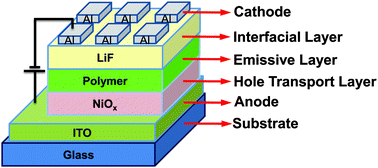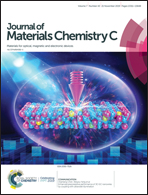High-performance polymer LED using NiOx as a hole-transport layer
Abstract
We present an investigation of polymer light-emitting diodes (PLEDs) with a nickelous oxide (NiOx) interlayer fabricated using a radio-frequency magnetron sputtering system. The NiOx layer has a stable conductivity, and it increases hole transport from an indium tin oxide anode to an emissive polymer relative to a poly[3,4-ethylenedioxythiophene] polystyrene sulfonate (PEDOT:PSS) interlayer. The NiOx layer also maximizes hole–electron recombination within the emissive layer, which ultimately enhances the luminous efficiency of the PLED. It can be found that the oxygen content of the NiOx film is an important factor for device performance. A PLED with a NiOx interlayer obtained using gas with a 66% oxygen ratio performs better than those containing NiOx layers obtained with other oxygen ratios or with PEDOT:PSS interlayers. It has a maximum luminance of 2737 cd m−2 (at 6.2 V) and a maximum current efficiency of 7.00 cd A−1 (at 39.0 mA cm−2). A PLED with a 66% oxygen-ratio NiOx interlayer provides a 133% increase in current efficiency and a 173% increase in mean quantum efficiency compared to a PLED with a PEDOT:PSS interlayer.



 Please wait while we load your content...
Please wait while we load your content...